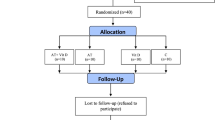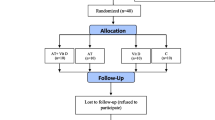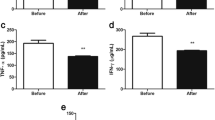Abstract
Introduction
Nuclear factor erythroid-2-related factor 2 (Nrf2), is an inducible transcription factor that reduced in type 2 diabetes(T2D) and increases oxidative stress and then stimulating antioxidant expression. The purpose of this RCT was to investigate the effects of HIIT induced H2O2, Nrf2 changes on Glutathione Peroxidase (GPx), Glutathione Reductase (GR), Catalase (CAT) and superoxide dismutase (SOD) in T2D.
Methods
Thirty-three male patients with T2D were randomly divided in 2 groups including to 12-weeks HIIT (10 rotations for 60 seconds (10 × 60s) set in constant watt mode at a pedal cadence of 80–100 revolutions/min) or a non-exercise control group. Nrf2, H2O2 and GPx, GR, Cat and SOD protein were measured in response to 12 weeks HIIT.
Results
Levels of Nrf2 and H2O2 showed high levels in HIIT with respect to control subjects after 12 weeks’ interventions (HIIT). Fasting plasma glucose (FPG) (p = 0.001), postprandial plasma glucose (PPG) (p = 0.001), glycated hemoglobin, (HbA1c) (p = 0.041), plasma total cholesterol (Tc) (p = 0.028), plasma triglyceride (TG) (p = 0.001), Na (p = 0.001), creatine kinase (Ck) (p = 0.035), alkaline phosphatase (ALP) (p = 0.025), hematocrit (Hct) (p = 0.008) and Cortisol (p = 0.001) were statistically significant in the T2D + HIITgroup. After 12 weeks’ interventions (HIIT), control group the Plasma CAT levels (p = 0.001) were found to be higher in HIIT group compared to control group.
Conclusion
Our results provide evidence that HIIT causes an increase in oxidative stress levels, which ultimately the body responds to increased antioxidant levels. Therefore, it is suggested that these indicators (HIIT and H2O2, Nrf2) can be considered as a therapeutic target for type 2 diabetic patients.



Similar content being viewed by others
Notes
Fibroblast Growth Factor
adenosine monophosphate activated protein kinase
References
Fu J, Hou Y, Xue P, Wang H, Xu Y, Weidong Q, Zhang Q, Pi J. Nrf2 in type 2 diabetes and diabetic complications: Yin and Yang. Curr Opin Toxicol. 2016;1(December 2018):9–19. https://doi.org/10.1016/j.cotox.2016.08.001.
Yang Z, Scott CA, Mao C, Tang J, Farmer AJ. Resistance exercise versus aerobic exercise for type 2 diabetes: a systematic review and Meta-analysis. Sports Med. 2014;44(4):487–99. https://doi.org/10.1007/s40279-013-0128-8.
Atalay M, Laaksonen DE. Diabetes, oxidative stress and physical exercise. J Sports Sci Med. 2002;1(1):1–14.
Pittaluga M, Sgadari A, Dimauro I, Tavazzi B, Parisi P, Caporossi D. Physical exercise and redox balance in type 2 diabetics: effects of moderate training on biomarkers of oxidative stress and DNA damage evaluated through comet assay. Oxidative Med Cell Longev. 2015;1–7. https://doi.org/10.1155/2015/981242.
de Oliveira EM, de Lima Ribeiro AKP, de Oliveira Silva DD, Nunes EFC, Santos GS, Kietzer KS, de Tarso Camillo de Carvalho P. Physical training on Glycemia and oxidative stress in type 2 diabetes: a systematic review. Rev Bras Med Esporte. 2020;26(1):70–6. https://doi.org/10.1590/1517-869220202601187572.
Yagishita Y, Uruno A, Yamamoto M. NRF2-Mediated Gene Regulation and Glucose Homeostasis. Molecular Nutrition and Diabetes: A Volume in the Molecular Nutrition Series. Elsevier Inc. 2016. https://doi.org/10.1016/B978-0-12-801585-8.00027-0.
Tofas T, Draganidis D, Deli CK, Georgakouli K, Fatouros IG, Jamurtas AZ. Exercise-induced regulation of redox status in cardiovascular diseases: the role of exercise training and detraining. Antioxidants. 2020;9(1):1–41. https://doi.org/10.3390/antiox9010013.
Muthusamy VR, Kannan S, Sadhaasivam K, Gounder SS, Davidson CJ, Hoidal JR, Wang L, Rajasekaran NS. Acute exercise stress activates Nrf2/ARE signaling and promotes antioxidant mechanisms in the myocardium. Free Radic Biol Med. 2012;52(2):1–7. https://doi.org/10.1016/j.freeradbiomed.2011.10.440.Acute.
Ostrom EL, Traustadóttir T. Aerobic exercise training partially reverses the impairment of Nrf2 activation in older humans. Free Radic Biol Med. 2020;160(August):418–32. https://doi.org/10.1016/j.freeradbiomed.2020.08.016.
David JA, Rifkin WJ, Rabbani PS, Ceradini DJ. The Nrf2/Keap1/ARE pathway and oxidative stress as a therapeutic target in type II diabetes mellitus. J Diabetes Res. 2017;2017. https://doi.org/10.1155/2017/4826724.
Vargas-Mendoza N, Morales-González Á, Madrigal-Santillán EO, Madrigal-Bujaidar E, Álvarez-González I, García-Melo LF, Anguiano-Robledo L, Fregoso-Aguilar T, Morales-Gonzalez JA. Antioxidant and Adaptative response mediated by Nrf2 during physical exercise. Antioxidants. 2019;8(6). https://doi.org/10.3390/antiox8060196.
Li S, Eguchi N, Lau H, Ichii H. The role of the Nrf2 signaling in obesity and insulin resistance. Int J Mol Sci. 2020;21(18):1–18. https://doi.org/10.3390/ijms21186973.
Tu W, Wang H, Li S, Liu Q, Sha H. The anti-inflammatory and anti-oxidant mechanisms of the Keap1/Nrf2/ARE signaling pathway in chronic diseases. Aging Dis. 2019;10(3):637. https://doi.org/10.14336/ad.2018.0513.
Azhdari A, Hosseini SA, Farsi S. Antioxidant effect of high intensity interval training on cadmium-induced cardiotoxicity in rats. Gene Cell Tissue. 2019;6(3). https://doi.org/10.5812/gct.94671.
Emami A-M, Homaee HM, Azarbayjani MA. Effects of high intensity interval training and curcumin supplement on glutathione peroxidase (GPX) activity and malondialdehyde (MDA) concentration of the liver in STZ induced diabetic rats. Iran J Diabetes Obes. 2016;8(3):129–34.
Fisher G, Schwartz DD, Quindry J, Barberio MD, Foster EB, Jones KW, Pascoe DD. Lymphocyte enzymatic antioxidant responses to oxidative stress following high-intensity interval exercise. J Appl Physiol. 2011;110(3):730–7. https://doi.org/10.1152/japplphysiol.00575.2010.
Lu K, Wang L, Wang C, Yang Y, Dayi H, Ding R. Effects of high-intensity interval versus continuous moderate-intensity aerobic exercise on apoptosis, oxidative stress and metabolism of the infarcted myocardium in a rat model. Mol Med Rep. 2015;12(2):2374–82. https://doi.org/10.3892/mmr.2015.3669.
Pimenta M, Bringhenti I, Souza-Mello V, Mendes IKDS, Aguila MB, Mandarim-de-Lacerda CA. High-intensity interval training beneficial effects on body mass, blood pressure, and oxidative stress in diet-induced obesity in ovariectomized mice. Life Sci. 2015;139:75–82. https://doi.org/10.1016/j.lfs.2015.08.004.
Done AJ, Traustadóttir T. Nrf2 mediates redox adaptations to exercise. Redox Biol. 2016;10(September):191–9. https://doi.org/10.1016/j.redox.2016.10.003.
Done AJ, Newell MJ, Traustadóttir T. Effect of exercise intensity on Nrf2 Signalling in young men. Free Radic Res. 2017;51(6):646–55. https://doi.org/10.1080/10715762.2017.1353689.
Duan FF, Guo Y, Li JW, Yuan K. Antifatigue effect of Luteolin-6-C-Neohesperidoside on oxidative stress injury induced by forced swimming of rats through modulation of Nrf2/ARE signaling pathways. Oxidative Med Cell Longev. 2017;2017. https://doi.org/10.1155/2017/3159358.
Holley AK, Dhar SK, St. Clair DK. Manganese superoxide dismutase vs. P53: regulation of mitochondrial ROS. Mitochondrion. 2010;10(6):649–61. https://doi.org/10.1016/j.mito.2010.06.003.
Crilly MJ, Tryon LD, Erlich AT, Hood DA. The role of Nrf2 in skeletal muscle contractile and mitochondrial function. J Appl Physiol. 2016;121(3):730–40. https://doi.org/10.1152/japplphysiol.00042.2016.
Wang P, Li CG, Qi Z, Cui D, Ding S. Acute exercise stress promotes Ref1/Nrf2 Signalling and increases mitochondrial antioxidant activity in skeletal muscle. Exp Physiol. 2016;101(3):410–20. https://doi.org/10.1113/EP085493.
Aro P, Emilio C, Guzmán JAR, Muñoz MES, González BEV. Effects of high intensity interval training versus moderate intensity continuous training on the reduction of oxidative stress in type 2 diabetic adult patients: CAT. Medwave. 2015;15(7):e6212. https://doi.org/10.5867/medwave.2015.07.6212.
Asghar M, George L, Lokhandwala MF. Exercise decreases oxidative stress and inflammation and restores renal dopamine D1 receptor function in old rats. Am J Physiol Ren Physiol. 2007;293(3):914–9. https://doi.org/10.1152/ajprenal.00272.2007.
George L, Lokhandwala MF, Asghar M. Exercise activates redox-sensitive transcription factors and restores renal D1 receptor function in old rats. Am J Physiol Ren Physiol. 2009;297(5):1174–80. https://doi.org/10.1152/ajprenal.00397.2009.
Kumar R, Negi PS, Singh B, Ilavazhagan G, Bhargava K, Sethy NK. Cordyceps Sinensis promotes exercise endurance capacity of rats by activating skeletal muscle metabolic regulators. J Ethnopharmacol. 2011;136(1):260–6. https://doi.org/10.1016/j.jep.2011.04.040.
Gounder SS, Kannan S, Devadoss D, Miller CJ, Whitehead KS, Odelberg SJ, Firpo MA, et al. Impaired transcriptional activity of Nrf2 in age-related myocardial oxidative stress is reversible by moderate exercise training. PLoS One. 2012;7(9). https://doi.org/10.1371/journal.pone.0045697.
Sun M, Huang C, Wang C, Zheng J, Zhang P, Yangshu X, Chen H, Shen W. Ginsenoside Rg3 improves cardiac mitochondrial population quality: mimetic exercise training. Biochem Biophys Res Commun. 2013;441(1):169–74. https://doi.org/10.1016/j.bbrc.2013.10.039.
Aguiar AS, Duzzioni M, Remor AP, Tristão FSM, Matheus FC, Raisman-Vozari R, Latini A, Prediger RD. Moderate-intensity physical exercise protects against experimental 6-Hydroxydopamine-induced Hemiparkinsonism through Nrf2-antioxidant response element pathway. Neurochem Res. 2016;41(1–2):64–72. https://doi.org/10.1007/s11064-015-1709-8.
Camiletti-Móiron D, Aparicio VA, Nebot E, Medina G, Martínez R, Kapravelou G, Andrade A, Porres JM, López-Jurado M, Aranda P. Una Dieta Alta En ProteÍna Produce EstrÉs Oxidativo En El Cerebro de Ratas: AcciÓn Protectora Del Ejercicio de Alta Intensidad Sobre La PeroxidaciÓn LipÍdica. Nutricion Hospitalaria. 2015;31(2):866–74. https://doi.org/10.3305/nh.2015.31.2.8182.
Merry TL, Ristow M. Nuclear factor erythroid-derived 2-like 2 (NFE2L2, Nrf2) mediates exercise-induced mitochondrial biogenesis and the anti-oxidant response in mice. J Physiol. 2016;594(18):5195–207. https://doi.org/10.1113/JP271957.
Zampieri S, Pietrangelo L, Loefler S, Fruhmann H, Vogelauer M, Burggraf S, Pond A, et al. Lifelong physical exercise delays age-associated skeletal muscle decline. J Gerontol - Ser A Biol Sci Med Sci. 2015;70(2):163–73. https://doi.org/10.1093/gerona/glu006.
Zhao J, Liu L, Li X, Zhang L, Lv J, Guo X, Chen H, Zhao T. Neuroprotective effects of an Nrf2 agonist on high glucose-induced damage in HT22 cells. Biol Res. 2019;52(1):53. https://doi.org/10.1186/s40659-019-0258-z.
Dieter BP. Dysregulation of Nrf2 signaling in diabetes: an opportunity for a multitarget approach. J Diabetes Metabol. 2015;06(01):1–12. https://doi.org/10.4172/2155-6156.1000475.
Barari A, Shirali S, Amini S, Manzari N. Interactive effect of saffron aqueous extract and aerobic training on glutathione peroxidase and malondialdehyde in men with type 2 diabetes. 2017;3(4).
Afzalpour ME, TaheriChadorneshin H, Abtahi-Eivary S-H, Ehsan A-G. Effect of intensive endurance training on rat brain and hepatic 8-Oxoguanine DNA glycosylase and 8-Hydroxy-2’-Deoxyguanosine levels. J Appl Pharma Sci. 2016;6(12):110–2.
Piri M, Mosalman HM, Azarbayjani MA, Khajelou A. The effect of aqueous extract of saffron and aerobic training on concentration of hepatic non-enzymatic antioxidant levels in Stz-Induced Diabetic Rats no; 2012.
Kalkhoran J, Shibak A. The combined effect of saffron and aerobic training on some indices of hepatic oxidative stress in diabetic rats. Sport Biosci. 2013;5(4):1–19.
Aghajani V, Nazari M, Shabani R. Impact of aerobic and resistance training supplemented with the consumption of saffron on glutathione peroxidase and malondialdehyde in men with type 2 diabetes impact of aerobic and resistance training supplemented with the consumption of saffron on glut. J Gorgan Univ Med Sci. 2019;21(3):24–33.
Siri WE. Body composition from fluid space and density. In: Brozek J, Hanschel A, editors. Techniques for measuring body composition. Washington, DC: National Academy of Science; 1961. p. 223–44.
Acknowledgements
We’d like to express our gratitude to the volunteers who took part in our research.
Author information
Authors and Affiliations
Corresponding author
Ethics declarations
Conflict of interests
The authors announce that the publishing of this paper does not involve any conflicts of interest.
Additional information
Publisher’s note
Springer Nature remains neutral with regard to jurisdictional claims in published maps and institutional affiliations.
Rights and permissions
Springer Nature or its licensor (e.g. a society or other partner) holds exclusive rights to this article under a publishing agreement with the author(s) or other rightsholder(s); author self-archiving of the accepted manuscript version of this article is solely governed by the terms of such publishing agreement and applicable law.
About this article
Cite this article
Kazemi, N., Afrasyabi, S. & Mohamadi Zadeh, M.A. The effects of high intensity interval training induced H2O2, Nrf2 changes on antioxidants factors in type 2 diabetes. J Diabetes Metab Disord (2022). https://doi.org/10.1007/s40200-022-01128-7
Received:
Accepted:
Published:
DOI: https://doi.org/10.1007/s40200-022-01128-7




